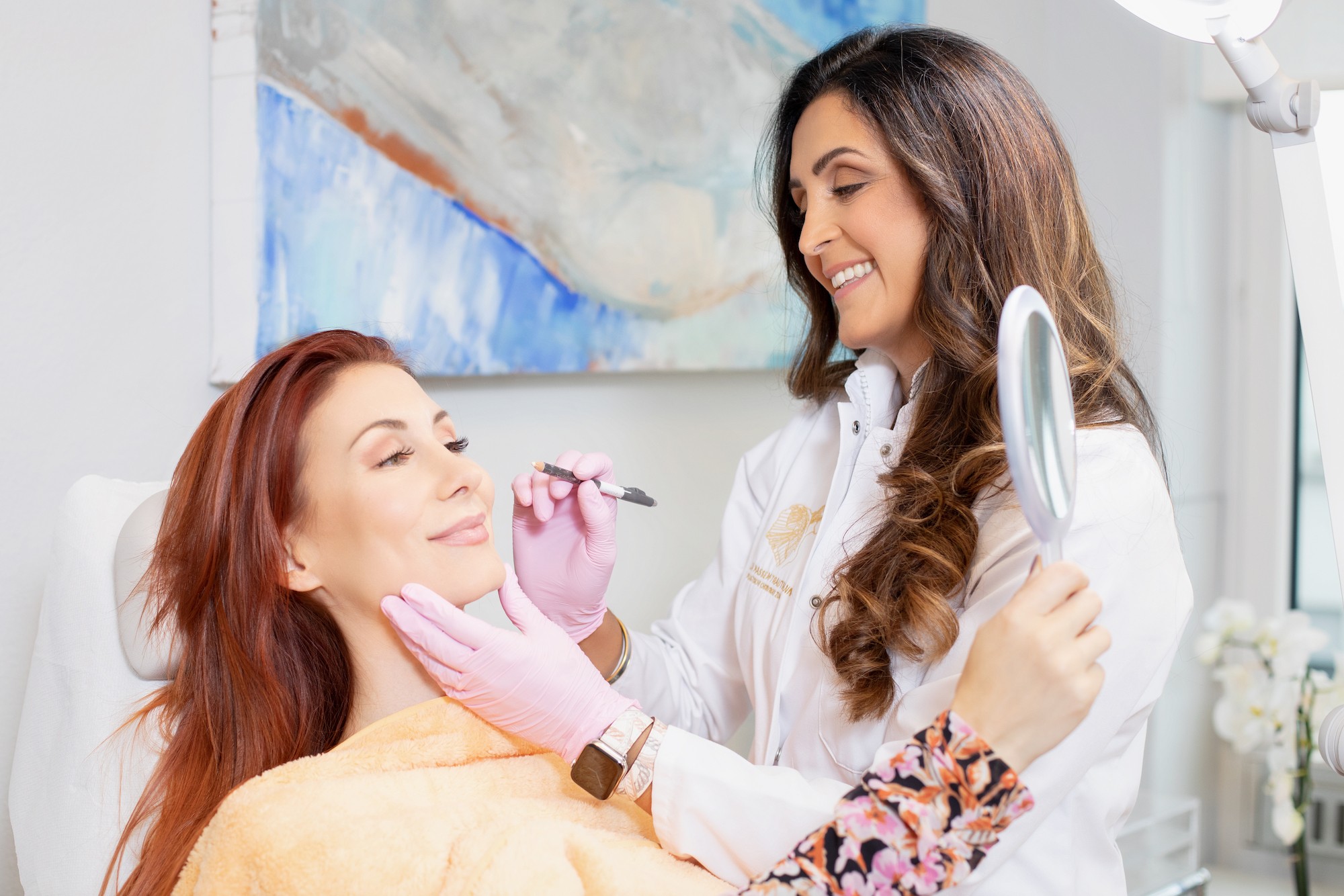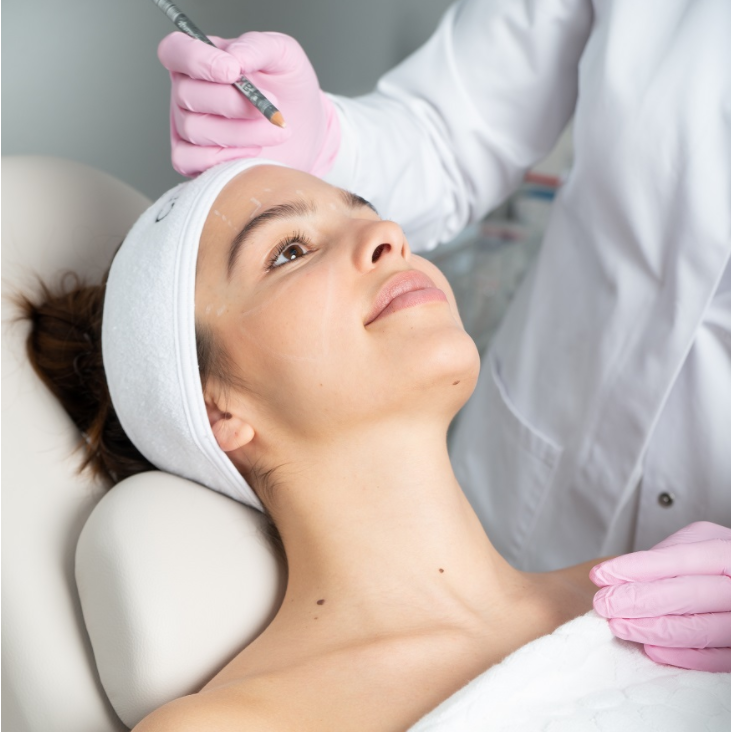Minimally invasive, outpatient

Thread lifts in Zug
Thread lifting is one of the many modern minimally invasive methods of restoring your youthful, vibrant appearance. My clinic in Zug places great importance on developing a tailor-made therapeutic concept for each of my patients, because no two faces and no two bodies are alike. I analyze the individual parts of my patients‘ faces separately and determine the best treatment strategy for each one. The available options include wrinkle filling with hyaluronic acid injections, Botox®, and aesthetic contouring using fat grafting. Thread lifting has a wide variety of applications. These specially designed threads can gently lift and reposition sunken areas of the face, while also stimulating the body’s natural production of collagen to restore skin quality over time. Thread lifts can be used to smooth bothersome wrinkles and tighten sagging skin.
Overview
Thread lifts in Switzerland at a glance
-
Procedure
-
Duration
Approx. 45-90 minutes
-
Anesthesia
Localized or twilight anesthesia
-
Rest and recovery
Around 5 days
-
Return to work
Within a few days
-
Follow-up care
Regular cooling; no make-up for one day
-
Risks
Swelling, redness, bruising, tightness
Consultation
Developing your individual treatment concept
Our initial consultation session is mostly about establishing what you personally find bothersome and what changes you would like to make. Besides taking plenty of time to understand your treatment goals, I will examine your skin and your facial features closely, determining the ideal procedure for each individual area to give you a fresh, natural look. I will also go over the individual steps of the treatment process with you and explain any potential risks involved. After your consultation, you can go home and think about whether you would like to proceed.

Preparation
Preparing for a thread lift
Thread lifts are a very gentle method of making your face look younger; special preparation is not usually necessary. Taking blood thinners can increase the risk of bruising, so please let me know if you have been prescribed those so that I can adjust the procedure accordingly. Also, please do not wear make-up when you come for your thread lift.
Treatment
What happens during a thread lift?
After cleaning and disinfecting your face, I mark the injection sites for the special threads. Local anesthesia ensures that the procedure is painless, but if you prefer, you can have your thread lift under twilight anesthesia. I use a special needle to bring the threads directly beneath the skin and position them within the tissue. Then I pull gently on the threads to create the desired lifting effect. The procedure usually takes between 45 and 90 minutes, depending on the number of threads used and the size of the treatment area.
If indicated and desired, thread lifts can also be combined with other treatment methods, including hyaluronic acid or autologous fat (lipofilling) injections, PRP therapy (vampire lifts) or Botox® treatment.
Follow-up care
After your thread lift
This modern method is quite gentle on the body; patients can return home almost immediately and go back to their usual routines. Plan to take it easy for the first few days, and make sure to keep facial movements to a minimum. Avoid eating or drinking anything hot for the first three days, and take a break from sports. If you experience swelling, exercise caution when cooling the treatment area. You can resume wearing make-up after 24 hours.
Risks
Are there any risks associated with thread lifting?
When in the hands of an expert, thread lifting is an effective, low-risk treatment method. You may experience slight swelling or redness in the areas where the threads are inserted; these are normal physical reactions, generally no cause for concern, and they will subside after a few days. Less common reactions include minor bruising and temporary numbness or tightness; in our experience, these symptoms pass quickly as well. Rejection responses and allergic reactions are not generally expected. My clinic uses absorbable threads—the body breaks them down naturally over time.
FAQ
More information and frequently asked questions on thread lifting
-
What are the threads made of?
A variety of materials have been used in thread lifts in the past, such as gold; nowadays, absorbable threads are used for reasons of patient safety. The most commonly used material is polydioxanone (PDO), a well-established medical suture material which is used in a variety of operations.
-
Who is a good candidate for thread lifting?
This method is suitable for patients interested in correcting sagging skin on their cheeks or neck, or improving their overall facial skin tone. Thread lifts can also be used on drooping eyelids, as a wrinkle treatment, or to gently lift the eyebrows.
Most of the above-named changes occur as part of the natural aging process. Thread lifting may not be able to stop your skin from aging, but it can have a visible and palpable effect on its undesirable effects.
-
When will I see the results?
The initial results are visible immediately after treatment. Since the threads themselves stimulate the body’s natural production of collagen and other structural proteins, the lifting effect intensifies over time and continues even after the threads have been reabsorbed into the body.
-
How long will the results last?
It varies from patient to patient. The number and composition of the threads can also impact how long the treatment results hold. As such, there is no way to make a blanket statement on this, though in our experience the effect lasts somewhere between one and three years.
-
Is there such a thing as permanent thread lifting?
Though permanent thread lifts are theoretically possible, my clinic does not offer them, as permanent threads increase the risk of tissue changes—which could develop months or even years after the procedure. There is little to no way of judging the risk of complications with non-absorbable threads, so in order to ensure my patients’ health, safety, and satisfaction, I do not use them.
-
How much do thread lifts cost?
The cost of the procedure depends on a variety of factors, including the number of threads and the size of the treatment area. I will calculate costs based on your individual treatment plan and go over both during your consultation.
Hours

